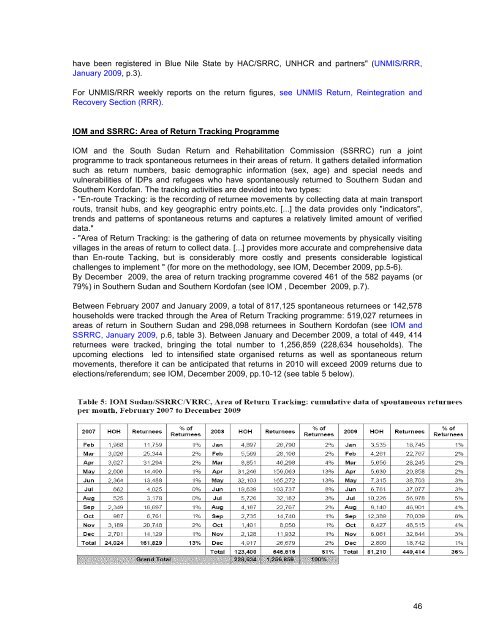SUDAN: Durable solutions elusive as southern IDPs return and ...
SUDAN: Durable solutions elusive as southern IDPs return and ...
SUDAN: Durable solutions elusive as southern IDPs return and ...
Create successful ePaper yourself
Turn your PDF publications into a flip-book with our unique Google optimized e-Paper software.
have been registered in Blue Nile State by HAC/SRRC, UNHCR <strong>and</strong> partners" (UNMIS/RRR,<br />
January 2009, p.3).<br />
For UNMIS/RRR weekly reports on the <strong>return</strong> figures, see UNMIS Return, Reintegration <strong>and</strong><br />
Recovery Section (RRR).<br />
IOM <strong>and</strong> SSRRC: Area of Return Tracking Programme<br />
IOM <strong>and</strong> the South Sudan Return <strong>and</strong> Rehabilitation Commission (SSRRC) run a joint<br />
programme to track spontaneous <strong>return</strong>ees in their are<strong>as</strong> of <strong>return</strong>. It gathers detailed information<br />
such <strong>as</strong> <strong>return</strong> numbers, b<strong>as</strong>ic demographic information (sex, age) <strong>and</strong> special needs <strong>and</strong><br />
vulnerabilities of <strong>IDPs</strong> <strong>and</strong> refugees who have spontaneously <strong>return</strong>ed to Southern Sudan <strong>and</strong><br />
Southern Kordofan. The tracking activities are devided into two types:<br />
- "En-route Tracking: is the recording of <strong>return</strong>ee movements by collecting data at main transport<br />
routs, transit hubs, <strong>and</strong> key geographic entry points,etc. [...] the data provides only "indicators",<br />
trends <strong>and</strong> patterns of spontaneous <strong>return</strong>s <strong>and</strong> captures a relatively limited amount of verified<br />
data."<br />
- "Area of Return Tracking: is the gathering of data on <strong>return</strong>ee movements by physically visiting<br />
villages in the are<strong>as</strong> of <strong>return</strong> to collect data. [...] provides more accurate <strong>and</strong> comprehensive data<br />
than En-route Tacking, but is considerably more costly <strong>and</strong> presents considerable logistical<br />
challenges to implement " (for more on the methodology, see IOM, December 2009, pp.5-6).<br />
By December 2009, the area of <strong>return</strong> tracking programme covered 461 of the 582 payams (or<br />
79%) in Southern Sudan <strong>and</strong> Southern Kordofan (see IOM , December 2009, p.7).<br />
Between February 2007 <strong>and</strong> January 2009, a total of 817,125 spontaneous <strong>return</strong>ees or 142,578<br />
households were tracked through the Area of Return Tracking programme: 519,027 <strong>return</strong>ees in<br />
are<strong>as</strong> of <strong>return</strong> in Southern Sudan <strong>and</strong> 298,098 <strong>return</strong>ees in Southern Kordofan (see IOM <strong>and</strong><br />
SSRRC, January 2009, p.6, table 3). Between January <strong>and</strong> December 2009, a total of 449, 414<br />
<strong>return</strong>ees were tracked, bringing the total number to 1,256,859 (228,634 households). The<br />
upcoming elections led to intensified state organised <strong>return</strong>s <strong>as</strong> well <strong>as</strong> spontaneous <strong>return</strong><br />
movements, therefore it can be anticipated that <strong>return</strong>s in 2010 will exceed 2009 <strong>return</strong>s due to<br />
elections/referendum; see IOM, December 2009, pp.10-12 (see table 5 below).<br />
46
















